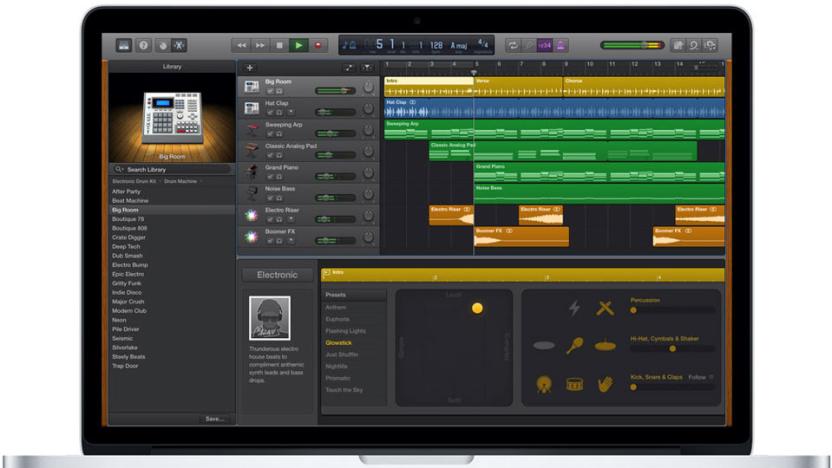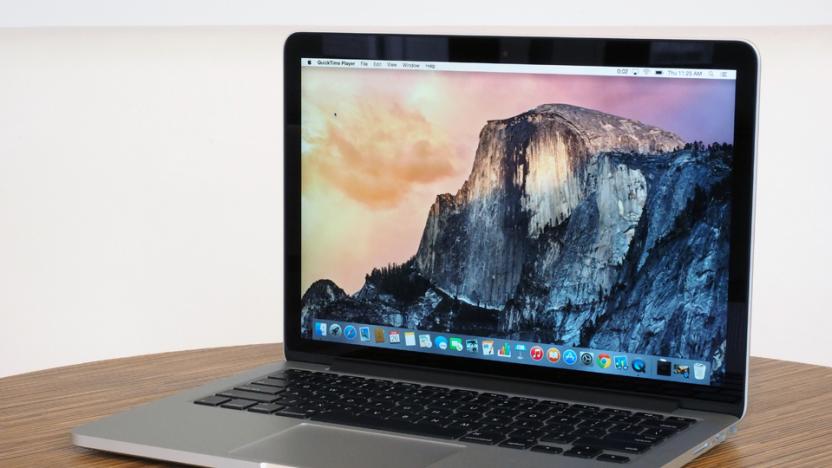forcetouch
Latest

Apple Watch rumor suggests 'solid state' buttons are coming
Now that the Apple Watch has built-in LTE, what could change in the next version? A rumor from Fast Company suggests that the Watch could follow Apple's "Force Touch" equipped laptops or iPhone 7 (and higher) models by making the button and digital crown "solid state" parts that don't actually move when clicked. While the crown is still said to rotate freely, a click would be simulated by vibrations from the Apple Watch's Taptic Engine. Like the laptops and phones, removing a moving part could make the device more reliable, easier to build, increase space for important things like extra battery, and more. The other part of the rumor is that these buttons could also host sensors capable of health tracking, and push the device toward a future where it doesn't have any buttons at all. But first, the moving parts have to go.

Car screens are getting force touch tech
Large touchscreen infotainment systems have become an important feature in modern cars, but they can also be a huge distraction for drivers. Synaptics thinks it would help if you could "feel" the screen, so it teamed with auto accessory supplier Valeo to create a new type of automotive display. It will be equipped with the company's ClearForce tech that provides force sensing and haptic feedback. The idea is to provide a safer interface that supports single finger, multi- and variable haptic touch, so that drivers or passengers can use the interface without looking at it.

The next iPhone's Force Touch reportedly trumps that on the Watch
Many expect the upcoming iPhone to include a pressure-sensitive screen, but just what will it entail? Will it be an upsized version of what you saw on the Apple Watch? Not by a long shot, if you ask 9to5Mac. Its sources claim that the future handset is using a next-generation version of Force Touch that recognizes three dimensions of input, not just the existing two. Reportedly nicknamed 3D Touch Display, it'll respond to multiple levels of pressure (a deeper press will trigger different functions, for instance) and allow app makers a whole new level of functionality. Just what Apple will do with this rumored feature is still up in the air, but you'll only have to wait a few days to get the full scoop.

A survey of Apple's input innovations
With Force Touch rumored to arrive on the new iPhones next week, let's take a look back at some of Apple's other notable input methods. Cupertino has always offered a unique spin on the norm, whether it's a mouse with no buttons, multi-touch gestures or a trackpad for your desktop. The pressure-sensitive Force Touch tech that debuted earlier this year on the Apple Watch and new MacBook is just the latest in a line of input innovations from Apple, a collection that's sure to grow in the months to come. [Lead image credit: Janitors/Flickr]

Force Touch to provide shortcuts on the upcoming iPhone
Reports came out earlier this year that the next iPhones will have Force Touch -- a feature that makes it easy to access particular content or functions by pressing down on a pressure-sensitive screen with haptic feedback. Now, 9to5mac has more details about the feature, which was introduced on the Apple Watch's screen and new MacBook's trackpad. Apparently, Force Touch for Apple's mobile devices is known internally as "Orb" and is meant to provide shortcuts for the platform. For instance, the publication's sources said pressing down on a destination on the Maps apps automatically begins turn-by-turn directions. Doing so on a song listing within the Music app, on the other hand, brings up a menu you can use to quickly add it to a playlist or save it for offline listening.

Apple's GarageBand uses trackpad pressure to control your tunes
Apple's Force Touch trackpads haven't done a whole lot in official apps besides fast scrolling and shortcuts, but they'll do considerably more if you grab the latest version of GarageBand. As of the 10.1 update, you can use the pressure-sensitive pad on newer MacBooks and MacBook Pros to vary the strength of certain tools -- if you want to subtly finesse a track using only your finger, you can. This is also a big upgrade if you're an aspiring DJ, since there's both a virtual morph pad as well as gobs of new dance- and hip-hop-friendly audio kits. You can check out all of GarageBand's new tricks for free if you already have GarageBand (not hard if you bought a relatively modern Mac), and it'll cost $5 if you're completely new.

Apple reportedly starts making force-sensitive iPhones
Those rumors of a pressure-sensitive iPhone just gained a little more weight. Bloomberg sources claim that Apple has begun "early production" of iPhone models that incorporate Force Touch input. Full-scale manufacturing would start as soon as July, if all goes well. Don't expect these devices to be conspicuously different, though. The tipsters say the devices will be similar on the outside to the iPhone 6 and 6 Plus, right down to the 4.7- and 5.5-inch screens. In other words, this could well be the stereotypical iPhone "S" release -- all the big improvements (such as Force Touch, a faster processor and upgraded cameras) may be found under the hood.

Websites can use Apple's pressure-aware trackpad in OS X El Capitan
Apple's pressure-sensitive Force Touch trackpad isn't tremendously useful in typical Mac software, but it might just get a new lease on life in OS X El Capitan. The new operating system's development tools let websites define what happens when you make that extra-strong click. You could favorite that adorable cat photo instead of zooming into it, for instance. There are some big gotchas associated with this, however. You'll need a circa-2015 Mac laptop to start with, but you'll also have to surf the web in Safari -- this won't help much if you're using an iMac, or prefer browsers like Chrome and Firefox. As clever as pressure-aware pages might be, you might not run into them that often without wider app and device support.

Apple adds Force Touch to 15-inch MacBook Pro, cuts 5K iMac prices
Now that the people are used to the pressure-sensitive trackpads in the new MacBook and smaller MacBook Pro, it's high time that the 15-inch model joined the party. That's why Apple has revealed that it's bringing Force Touch to the larger of its pro laptops. It's not just the user interface that's been tweaked, since there's faster flash storage, a further hour of battery life and AMD's new discrete graphics hardware tucked inside. At the same time, the company has managed to get the base price for its 27-inch Retina Display iMac down to $1,999 by sacrificing the Fusion Drive. Even better, however, is that the top-line 5K iMac with a 3.5GHz chip will now set you back $2,299, at least before you pick some build-to-order options, obviously. Both devices are available from today at the company's online and retail stores, as well as authorized resellers.

MacBook review: Apple reinvents the laptop again
For months, the internet was abuzz with two similar, and somewhat contradictory, Apple rumors. Depending on whom you believed, the famously secretive company was working on either a 12-inch "iPad Pro" or a Retina display MacBook Air. To date, neither of these products has materialized, but there's reason to believe that both rumors were actually pointing toward the new 12-inch MacBook. The laptop, which goes on sale tomorrow, is in many ways a traditional notebook, with an Intel processor, OS X and a unibody aluminum enclosure similar to what you'll find on the MacBook Air and Pro. At the same time, it takes some cues from the iPad, including space gray and gold color options, and a slim, fanless design that makes room for just one miniature USB port. With the lid shut, it looks at once like a tablet with a keyboard attached, as well as the two-pound computer that it actually is. It's the future of laptops, at least as Apple sees it, but it's also not without compromises: To build a machine this compact, the company had to reimagine everything from the keyboard to the trackpad to the components inside. And yes, the port selection, too. All that in the name of building the thinnest and lightest MacBook ever, not to mention the smallest one with a Retina display. In many ways, it's aimed at the same person the original Air was: a loyal Mac user who wants the most portable laptop that money can buy. But are you that person? And even if you are, is it worth the $1,299 asking price?

MacBook Pro with Retina display review (13-inch, 2015)
Nope, it's not the new MacBook. That review will need to wait until next month. What we have here is the 13-inch MacBook Pro with Retina display. For all intents and purposes, it's the same one we last tested in late 2013, except for one important thing: It swaps out the old trackpad in favor of a pressure-sensitive "Force Touch" pad that responds differently depending on how hard you bear down on it. (A hard-press on the skip button in QuickTime, for instance, will let you fast-forward at warp speed.) In addition, the new MBP brings all the spec upgrades you'd expect in a system refresh, including faster SSDs, fresh graphics and Intel's latest Core processors. At $1,299-plus, it's priced the same as before, and since the design and Retina display haven't changed, you're likely to enjoy it as much as you did the last-gen model. I can't promise you'll love the new touchpad, though.

iFixit explains how Apple's new MacBook haptic trackpad works
Apple's new range of MacBooks have something particularly new inside them: the Force Touch trackpad. No longer hinged like previous Apple laptops, the new touchpad houses a "Haptic Engine", outputting tactile feedback that will let you "feel" what's happening on-screen. iFixit's taken a closer look at how Apple did it, and while the trackpad is no longer hinged, there are now four spring mounts underneath. That haptic engine? A load of wires coiled around a magnetic core, which makes that all important vibrational feedback.

WSJ: The next iPhone will get a force-sensitive touchscreen
Apple's recently announced MacBook and Watch both understand the difference between a gentle press and a hard shove. It should surprise nobody that the company is likely to add this technology, dubbed Force Touch, to the next generation of iPhones. The Wall Street Journal has called around its circle of people familiar with the matter, who all say that it'll be the headline feature for the iPhone 6S and 6S Plus. In addition, those in the know believe we'll soon get a fourth color option to choose from: pink.

Apple's new MacBook has a completely redesigned trackpad
Not surprisingly, the main attraction of today's Apple event is the company's new smartwatch. But there's more, a lot more leading up to that announcement. As part of its new MacBook unveiling, Apple has revealed a newly designed trackpad, dubbed Force Touch. The redesigned trackpad comes with what Apple is calling a Taptic Engine, which produces tactile feedback that lets you "feel" what's happening on the screen, rather than just see it. It's "not a diving board," Apple Senior Vice President of Worldwide Marketing Phil Schiller said on stage about the trackpad, which is now pressure-sensitive and no longer hinged (as was the case on previous MacBooks).








